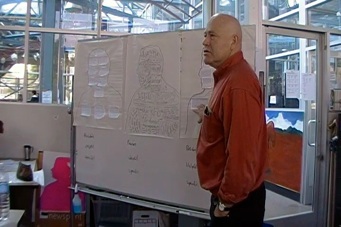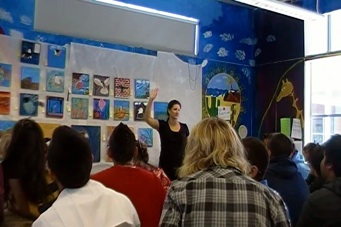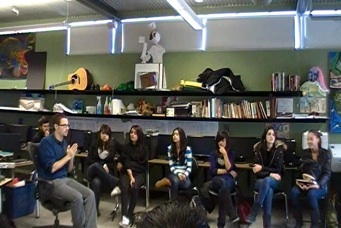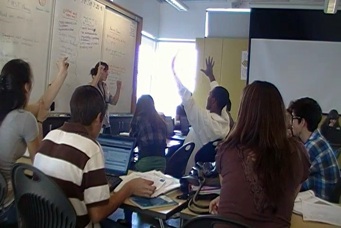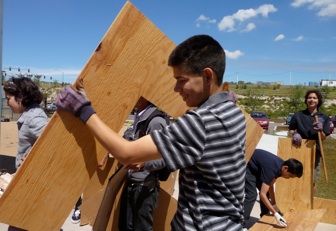
School Leadership Program
School Leadership Project: HTH Structures in Action
Project Overview
My School Leadership project focuses on classroom structures that facilitate project-based learning in student-centered classrooms. People often believe that project-based learning means unstructured learning. They envision classrooms where students have completely free rein, with little teacher guidance or supervision. As a result, they argue that students who “need more structure” learn poorly in project-based classrooms.
In reality, when project-based learning is at its best, teachers do provide their students with a great deal of structure. These practices just look different than traditional notions of structure, such as students sitting silently taking notes while a teacher lectures.
Throughout this school year, I have been identifying and videotaping classroom structures that HTH teachers use to facilitate project-based learning. Structures I have documented include: critique and conversation protocols, role delegation, daily planning and reflection, and routines for creating a strong classroom community. These structures facilitate the smooth implementation of projects by building skills of cooperation and communication among team members. They also help students develop the ability to stay organized and motivated in learning situations that require self-initiative and independence from teacher control.
As a final product, I helped produce a website showcasing video clips of effective structures in action at several High Tech High schools. These videos, along with supplemental print materials, can serve as a tool in training teachers who are new to project-based learning or who need help creating student-centered classrooms. My hope is that this resource can also spur experienced project-based teachers to refine the structures they use in their classrooms and inspire them to try out structures they never considered before.
Project Design
Research Question:
• What structures do teachers at HTH use to facilitate project-based learning?
Subquestions:
• How do PBL teachers help students stay organized and motivated in learning situations that require self-initiative and independence from teacher control?
• How do teachers build other skills that are integral to project-based learning: cooperation, planning, perseverance, reflection, etc.?
• How are HTH teachers building community in their classrooms to create a safe space for project-based learning?
Data Collection:
• I conducted a survey with the teachers at HTHCV and one-on-one interviews with teachers at other HTH schools to determine what structures they are using in their classrooms.
• I videotaped these structures in practice in classrooms at HTHCV, HTH, HTM, HTHMA, and HTHNC.
• I gathered samples of student work and print materials that teachers have created to facilitate project work (e.g., daily planning sheets and reflections, critique protocols).
•If time permits, I would also like to conduct surveys and focus groups with students to gauge which structures they find most helpful.
Data Analysis:
• I have watched clips of the videotapes with fellow graduate students in the School Leadership program in a consultancy protocol.
• I plan to watch more clips of the videotapes with focus groups of school directors, HTHCV teachers, and teachers in the HTH credentialing program. The purpose of these focus groups would be to determine how best to share the video footage to serve the needs of different teachers.
Timeline:
September 2009
• Conducted observations in many classrooms at HTHCV to get a sense of the structures used by different teachers. Took extensive notes on observations.
October 2009
• Conducted survey with HTHCV teachers to find out what structures they are using in their classrooms.
• Began to videotape structures in action at HTHCV.
November-December 2009
• Continued to videotape structures in action at HTHCV.
• Shared selected video clips with directors of School Leadership program and Rob Riordan for feedback on how best to edit the clips.
-
•Began editing video footage into clips of roughly five minutes or less.
January 2010
• Sent out e-mails to teachers at other HTH schools.
• Conducted one-on-one in-person interviews with teachers at other HTH schools to determine what structures they are using in their classrooms. Scheduled times to videotape their structures in action.
• Began videotaping at other HTH schools.
February 2010
• Continued to videotape structures in action at HTHCV, HTH, and HTM.
• Met with web designer Patrick Hayman to discuss ideal web platform for video clips.
• Shared video clips with fellow School Leadership students in a consultancy protocol, for feedback on how to make the video clips useful for different audiences.
March 2010
• Shared video clips with new multimedia collaborators Doug Beacom and Jason Smith. Planned to edit videos in different formats to share with a test audience.
-
•Began to gather student work samples and print materials to accompany videos.
April 2010
-
•Contacted a living resource--Jim Lengel of Hunter College’s Digital Video Analysis Project--to understand how other educational organizations are using videos in training new teachers. Participated in a WebEx demo with Jim Lengel to understand the video analysis software he has created.
-
•Worked with Doug Beacom to establish a new work flow for editing and uploading video clips.
-
•Continued to edit video footage into clips based on new workflow.
• Began uploading videos to the HTH Videos website.
May 2010-June 2010
• Continued editing videos and building content on the HTH Structures pages.
• Share edited video clips with veteran teachers and directors.
August 2010
-
•Share completed website with new teachers at the HTH Odyssey and Methods class.
-
•Write UnBoxed article to reflect on the experience and share the website with a broader audience.

